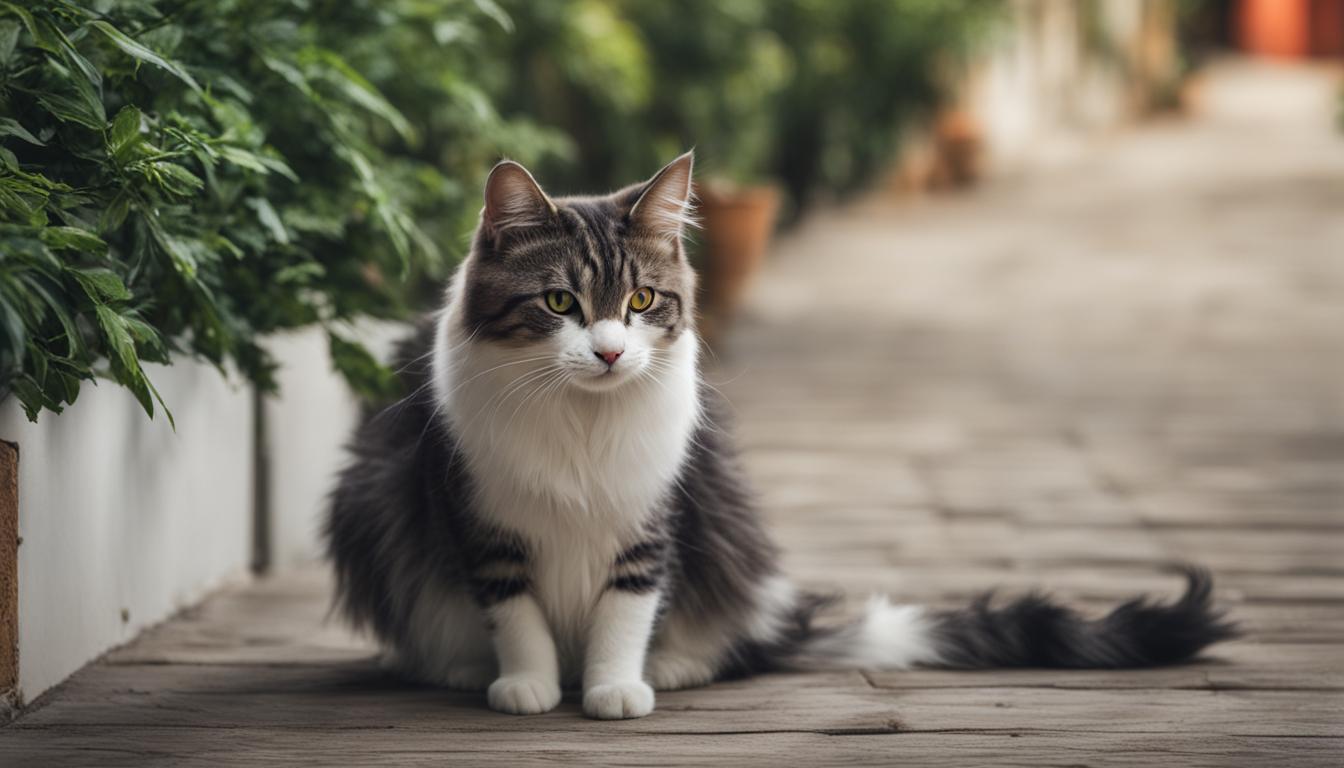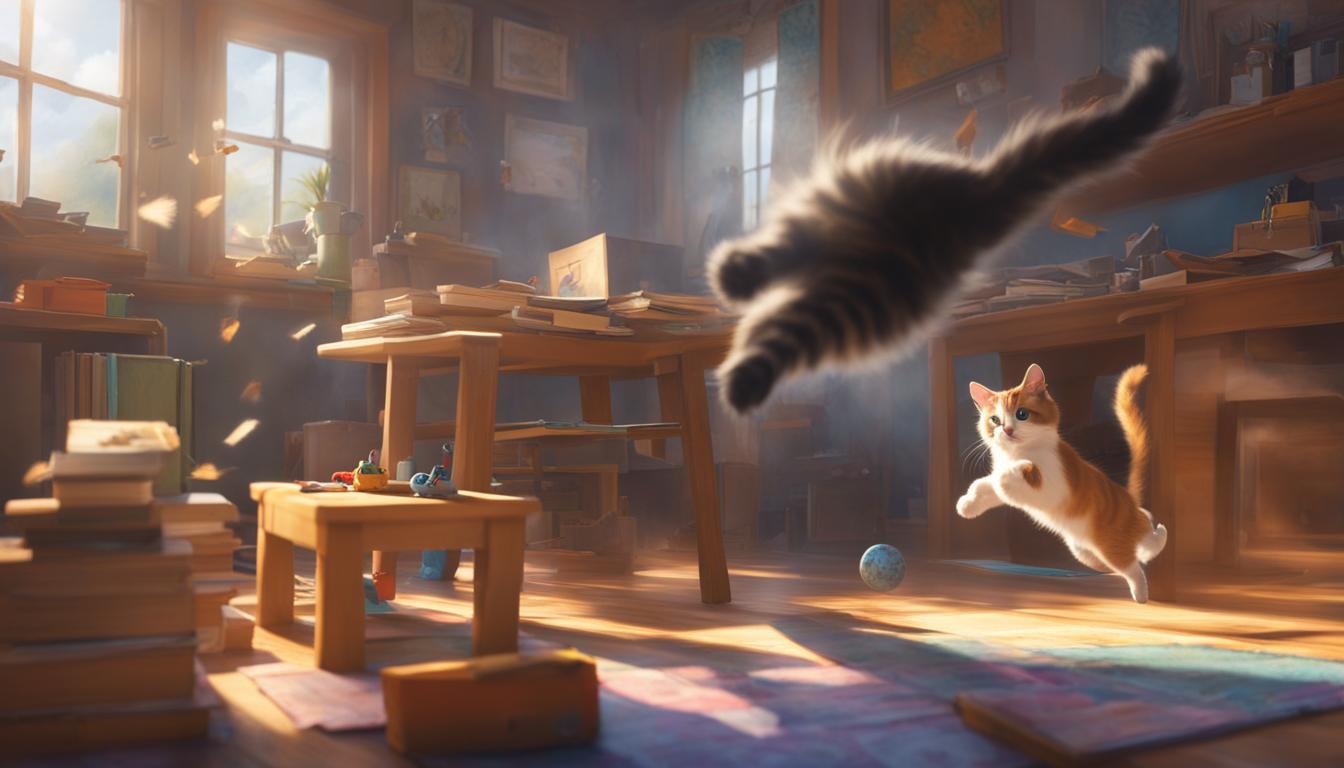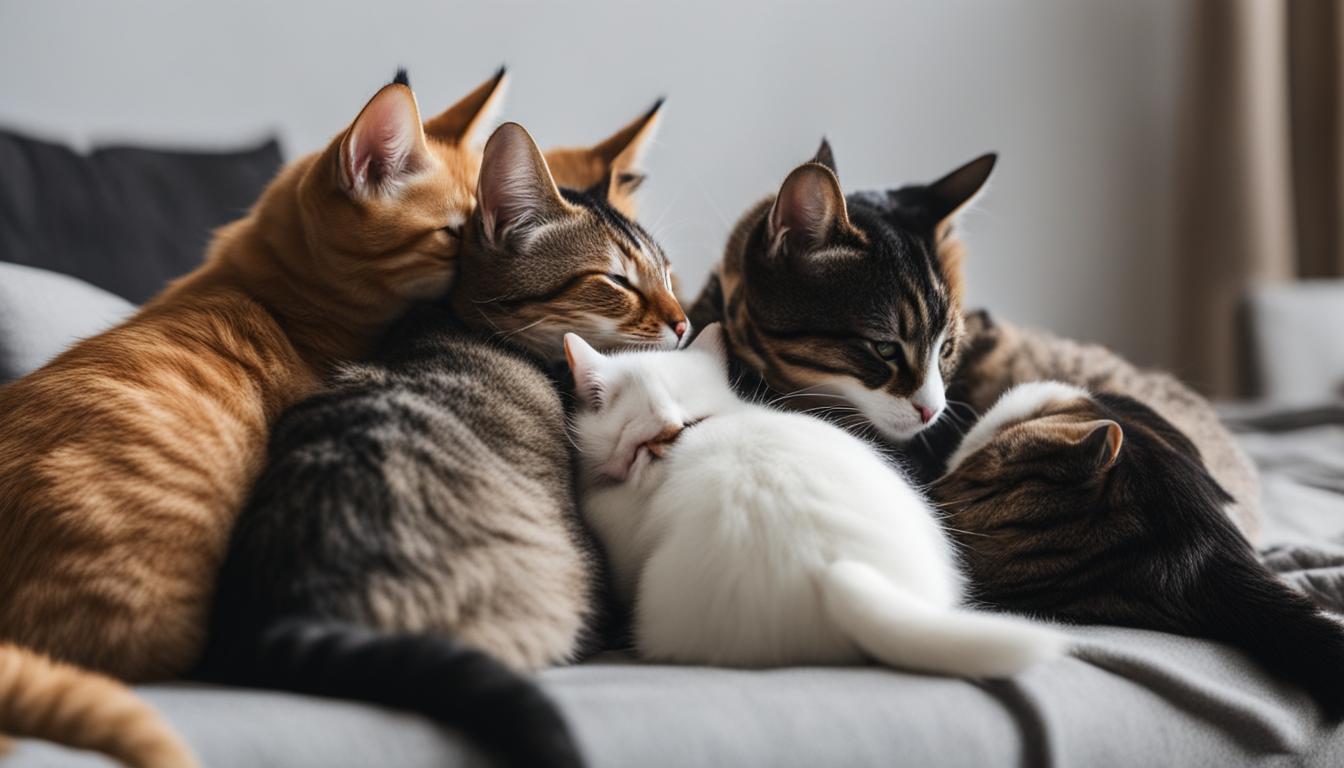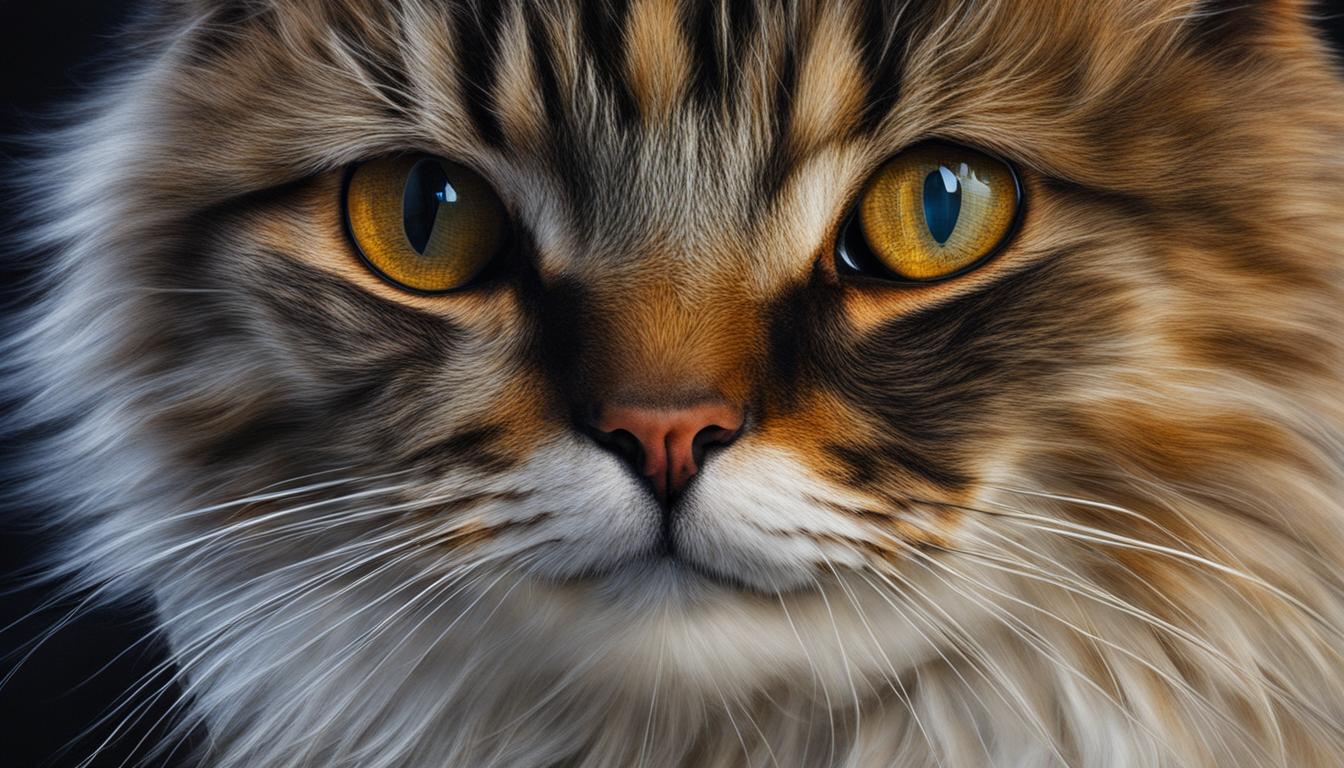As a cat owner, have you ever wondered why your feline friend becomes a night owl as soon as the sun sets? I know I have! Cats have always piqued my curiosity with their mysterious behavior and unique sleep patterns. In this article, we’ll delve into the fascinating world of feline nocturnal activities and sleep patterns, helping you gain a deeper understanding of your cat’s behavior and offering tips on managing their nighttime activity.
Cats are not truly nocturnal creatures; they are crepuscular, which means they are most active during the twilight hours of dawn and dusk. This aligns with their evolutionary history as hunters of prey that are also active during these times. Cats have a natural instinct to seek out their meals during these cooler hours, ensuring a combination of darkness for cover and enough light for effective hunting. But what about their sleep cycles?
Cats are renowned for their love of snoozing, often taking up to 15 to 20 hours of shut-eye each day. Older cats may even require more sleep. It’s important to understand and accept their natural sleep-wake cycle, rather than trying to change it entirely. By doing so, we can better manage their behavior and foster a harmonious living environment for both cats and their owners.
Key Takeaways:
- Feline behavior is crepuscular, meaning cats are most active at dawn and dusk.
- Cats sleep for an average of 15 to 20 hours a day, with older cats needing even more sleep.
- Understanding and accepting cats’ sleep-wake cycles can help owners manage their behavior without trying to change it entirely.
- Providing dedicated playtime during the day and toys for nighttime can help redirect cats’ energy and minimize disturbances at night.
- Consulting with a veterinarian is crucial if a cat’s sleep patterns significantly change, as it may indicate an underlying health issue.
The Science behind Cat Sleep Patterns
Understanding the sleep patterns of our feline friends is crucial to providing them with optimal care. Cats are not nocturnal creatures, but rather crepuscular, meaning they are most active during dawn and dusk. This behavior aligns with their evolutionary history as hunters, as it is during these times that their prey is also most active.
Cats sleep for an average of 12 to 15 hours a day, which may seem like a lot compared to humans, but it is essential for their overall well-being. However, unlike humans who experience deep sleep, cats remain semi-alert during their slumber. This vigilance is a result of their survival instincts, allowing them to stay aware of potential threats or hunting opportunities even while resting.
To better understand cat sleep patterns, it is helpful to consider their natural sleep cycle. Cats go through four stages of sleep, including the light sleep stage, deep sleep stage, REM (Rapid Eye Movement) sleep stage, and the awake stage. Unlike humans, cats do not experience prolonged periods of REM sleep, and their sleep cycles are shorter and more frequent. This is why cats can wake up and move around more easily compared to humans during the night.
So, what are the reasons behind cat night waking? One possible explanation is that cats have retained their ancestral hunting instincts, and their desire for play or attention during the night may mimic their natural stalking and hunting behaviors. Providing dedicated playtime during the day can help relieve their pent-up energy and minimize nighttime disturbances. Interactive toys, such as puzzle feeders or toys that mimic prey, can also keep cats engaged and mentally stimulated during the night.
| Reasons for Cat Night Waking: | How to Address: |
|---|---|
| Cats’ natural hunting instincts | Provide dedicated playtime during the day and interactive toys at night |
| Lack of mental and physical stimulation | Engage cats with interactive toys and puzzle feeders |
| Environmental factors (noises, lights) | Create a quiet and peaceful sleep environment for cats |
| Underlying medical conditions | Consult with a veterinarian to rule out any health issues |
“Cats sleep for an average of 12 to 15 hours a day, remaining semi-alert even during their slumber. This vigilance is a result of their survival instincts, allowing them to stay aware of potential threats or hunting opportunities even while resting.”
Understanding the Cat Sleep Cycle
The cat sleep cycle consists of various stages, each serving a specific purpose in their overall sleep pattern. The light sleep stage is characterized by relaxed muscles and increased brain activity. During the deep sleep stage, cats experience reduced brain activity and relaxation of muscles. REM sleep, which is associated with dreaming in humans, is shorter and less common in cats.
It’s important to note that cats’ sleep patterns can vary based on their age, health, and individual personalities. Senior cats, for example, may experience changes in their sleep-wake cycles and require more frequent napping. Understanding and accommodating these variations can help ensure that cats of all ages receive the rest they need.
In the next section, we’ll explore the behavior aspects of cat nighttime activity and how to create a cat-friendly night routine that promotes restful sleep for both cats and their owners.
Understanding Cat Nighttime Behavior
Many cat owners may find their feline friends becoming surprisingly active during the night, causing sleep disturbances and leaving them wondering about their cat’s nocturnal behavior. It’s important to remember that cats are crepuscular creatures, meaning they are naturally more active during the twilight hours of dawn and dusk. This behavior is deeply ingrained in their DNA as hunters, as these are the times when their prey is most active. So, why do cats wake up at night and how can we manage their nighttime antics?
One of the main reasons cats wake up at night is their desire for play and attention during these hours. Cats have a high energy level, and if they’re not provided with enough physical and mental stimulation during the day, they may seek it out when everyone else is trying to sleep. To tackle this issue, it’s important to provide dedicated playtime during the day to help burn off excess energy. Interactive toys and engaging activities can help redirect their energy and keep them entertained, reducing their inclination to wake up at night.
Additionally, it can be helpful to provide cats with toys and activities that can keep them occupied during the night. Puzzle feeders or treat-dispensing toys can be a great way to mentally stimulate your cat while also encouraging them to focus on something other than waking you up. Creating a comfortable and stimulating environment for your cat, with cozy sleeping spots and interactive toys within their reach, can go a long way in promoting a peaceful night’s sleep for both you and your feline companion.
Managing Nocturnal Cat Behavior: Tips and Tricks
Here are some practical tips for managing your cat’s nighttime behavior:
- Establish a consistent routine: Cats thrive on routine and find comfort in predictability. Establish a regular schedule for playtime, feeding, and bedtime to help regulate your cat’s sleep-wake cycle.
- Provide mental and physical stimulation: Engage your cat in interactive play sessions during the day to tire them out and satisfy their primal hunting instincts.
- Create a cat-friendly sleeping environment: Make sure your cat has access to comfortable and cozy sleeping areas away from distractions and disturbances.
- Avoid reinforcing unwanted behavior: If your cat wakes you up at night, avoid giving in to their demands for attention or food. By not rewarding their behavior, you can help discourage them from repeating it.
- Consult with a veterinarian: If your cat’s nighttime behavior is excessive or disruptive, it’s always a good idea to consult with a veterinarian to rule out any underlying health issues or to seek professional advice on managing their behavior.
By understanding and addressing your cat’s nocturnal behavior, you can create a harmonious sleep environment for you and your feline friend, ensuring a good night’s rest for everyone involved.
Creating a Cat-Friendly Night Routine
Adapting to a cat’s nocturnal habits can be challenging, but by establishing a cat-friendly night routine, you can help promote better sleep for both you and your feline companion. Here are some tips to create a peaceful and restful environment:
1. Engage in Interactive Play
Prior to bedtime, engage in interactive play sessions with your cat to fulfill their hunting instincts. Use toys that simulate prey and encourage your cat to chase, pounce, and jump. This will help tire them out and release their pent-up energy, making them more likely to settle down for sleep.
2. Provide Cozy and Quiet Sleeping Places
Ensure that your cat has access to cozy and comfortable sleeping places throughout your home. Cats enjoy soft beds, blankets, or even dedicated cat trees where they can curl up and feel secure. Place these sleeping areas in quiet spots away from noise and distractions, creating a peaceful space for them to relax and unwind.
3. Maintain a Consistent Nighttime Routine
Cats thrive on routine, so it’s important to establish a consistent nighttime routine. Set a specific time for feeding, play, and winding down before bed. By sticking to a predictable schedule, your cat will learn to anticipate and prepare for sleep, increasing the chances of a restful night for both of you.
4. Avoid Reinforcing Unwanted Behavior
When your cat wakes up at night, it’s essential to avoid reinforcing the behavior by not feeding, playing with, or giving attention to them. This sends a clear signal that nighttime is for rest and sleep. Ignoring their meowing or restless behavior may be challenging at first, but it will ultimately help train them to sleep through the night.
| Benefits of a Cat-Friendly Night Routine | How to Implement |
|---|---|
| Improved sleep for both you and your cat | Engage in interactive play before bedtime |
| Reduced nighttime disturbances and meowing | Provide cozy and quiet sleeping places |
| Established sleep-wake cycle for your cat | Maintain a consistent nighttime routine |
| Enhanced bonding between you and your cat | Avoid reinforcing unwanted behavior |
Creating a cat-friendly night routine may require some patience and consistency, but it’s worth the effort to ensure a peaceful and restful night’s sleep for both you and your feline companion. By understanding and adapting to your cat’s nocturnal habits, you can create an environment that supports their natural instincts and promotes their overall well-being.
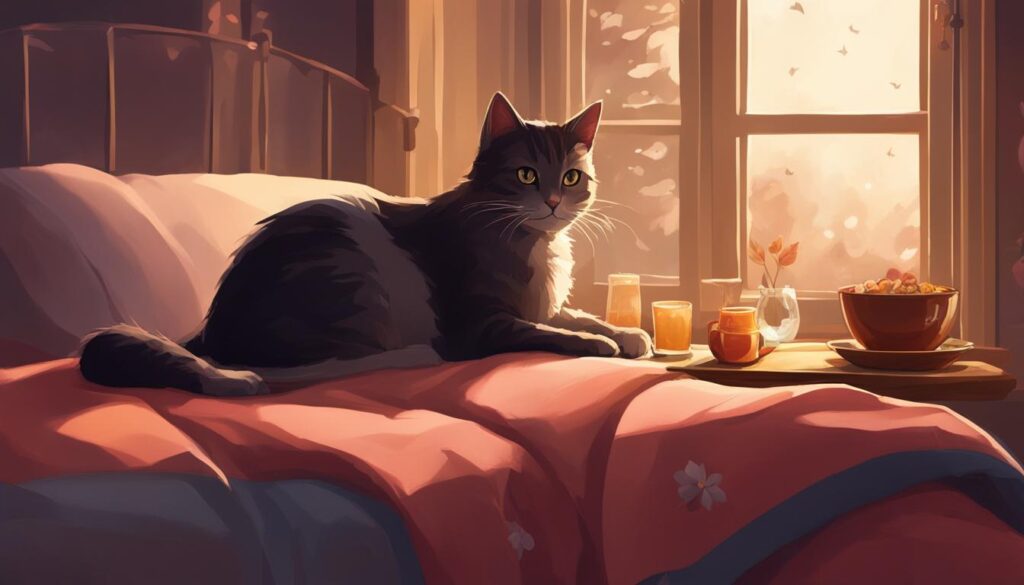
Managing Cat Sleep Disorders
As much as we love our feline friends, sometimes they can experience sleep disorders that can disrupt their natural sleep patterns. It’s important for cat owners to be aware of these disorders and take steps to manage them effectively.
One common sleep disorder in cats is excessive sleep. While cats are known for being champion nappers, if your cat seems to be sleeping excessively and showing a lack of interest in activities, it could be a sign of an underlying health issue. Conditions such as hyperthyroidism or chronic pain can contribute to excessive sleepiness in cats. If you notice a significant change in your cat’s sleep patterns, it’s important to consult with a veterinarian to rule out any medical concerns.
On the other hand, some cats may experience restlessness at night, causing them to be more active than usual during sleeping hours. Restlessness can be caused by various factors, including anxiety, discomfort, or simply a disruption in their sleep-wake cycle. Creating a calming environment for your cat, providing them with comfortable sleeping areas, and engaging in interactive play sessions during the day can help redirect their energy and promote a more restful night’s sleep.
| Sleep Disorder | Symptoms | Possible Causes |
|---|---|---|
| Excessive Sleep | Lethargy, lack of interest, prolonged sleeping | Underlying medical conditions (hyperthyroidism, chronic pain) |
| Restlessness at Night | Excessive activity during sleeping hours | Anxiety, discomfort, disrupted sleep-wake cycle |
“Just like humans, cats can experience sleep disorders that can affect their overall well-being. It’s important for cat owners to be observant of their cat’s sleep patterns and behavior, as these can provide clues to any underlying issues. By addressing sleep disorders promptly and seeking proper veterinary care, we can help our feline friends achieve a healthier and more restful sleep.”
Remember, every cat is unique, and their sleep needs can vary. If you have concerns about your cat’s sleep patterns or behavior, it’s always best to consult with a veterinarian who can provide personalized advice and guidance. By understanding and managing cat sleep disorders, we can ensure our beloved companions have the best possible sleep quality and live happier, healthier lives.

Tips for a Quiet Night with Cats
Ensuring a peaceful sleep environment for both you and your feline companion is essential for a harmonious night. Here, I’ve gathered some valuable tips to help minimize cat nighttime disturbances and create a serene atmosphere for a good night’s rest.
Creating a Peaceful Sleep Environment
To promote a calm and relaxing sleep environment, consider the following:
- Keep litter boxes clean and well-lit to encourage your cat to use them during the night.
- Provide cozy sleeping areas with comfortable beds or blankets where your cat can retreat to for a restful sleep.
- Avoid playing with your cat on the bed to prevent associating it with playtime and potential disruptions during the night.
Redirecting Energy with Interactive Toys
Cats are naturally active creatures, and providing them with mental and physical stimulation during the day can help tire them out before bedtime. Here are some ideas:
- Offer interactive toys that engage your cat’s hunting instincts, such as puzzle feeders or toys that dispense treats.
- Use food puzzle toys for overnight feeding to keep your cat entertained while also satisfying their hunger.
- Provide opportunities for exploratory play during the day, like hiding treats around the house or creating an obstacle course for your cat to navigate.
Minimizing Cat Nighttime Disturbances
By setting boundaries and establishing a consistent routine, you can help reduce cat nighttime disturbances:
Creating a dedicated playtime routine during the day can help tire out your cat and minimize their need for attention during the night. Avoid reinforcing unwanted behavior by not feeding or engaging with your cat when they wake up at night. Instead, provide them with calming reassurance and redirect their energy to appropriate activities.
Remember, every cat is unique, so be patient and experiment with different strategies to find what works best for you and your feline friend. With a little effort and understanding, you can enjoy a quiet night’s sleep while nurturing a strong bond with your beloved cat.
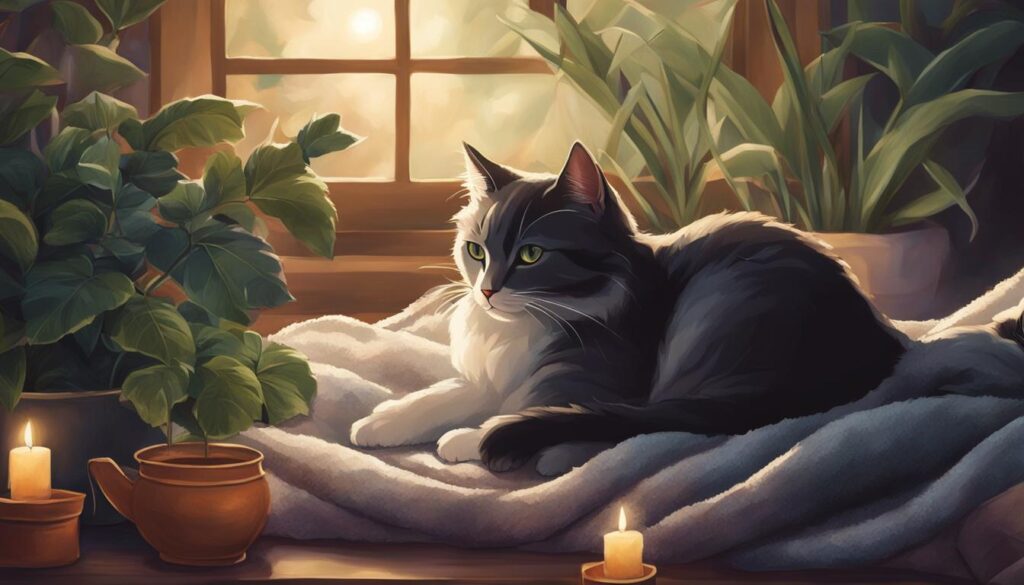
Understanding Senior Cat Sleep Patterns
As our beloved cats age, it’s important to recognize that their sleep patterns and behaviors may undergo changes. Just like us, senior cats may experience variations in their sleep-wake cycles and may require adjustments to their sleep routines for optimal rest and comfort.
Adapting to changes in senior cat sleep patterns starts with understanding the aging process. Older cats may sleep more during the day and wake up frequently during the night. This can be attributed to age-related physical changes, such as arthritis or cognitive decline, which may affect their ability to achieve deep and uninterrupted sleep.
To ensure that senior cats experience quality sleep, it’s crucial to provide them with ample comfort and resources. Creating cozy and quiet sleeping areas, with soft bedding and easy accessibility, can help them settle down for a good night’s rest. Additionally, regular veterinary check-ups can help identify and address any underlying health issues that may be contributing to disruptive sleep patterns.
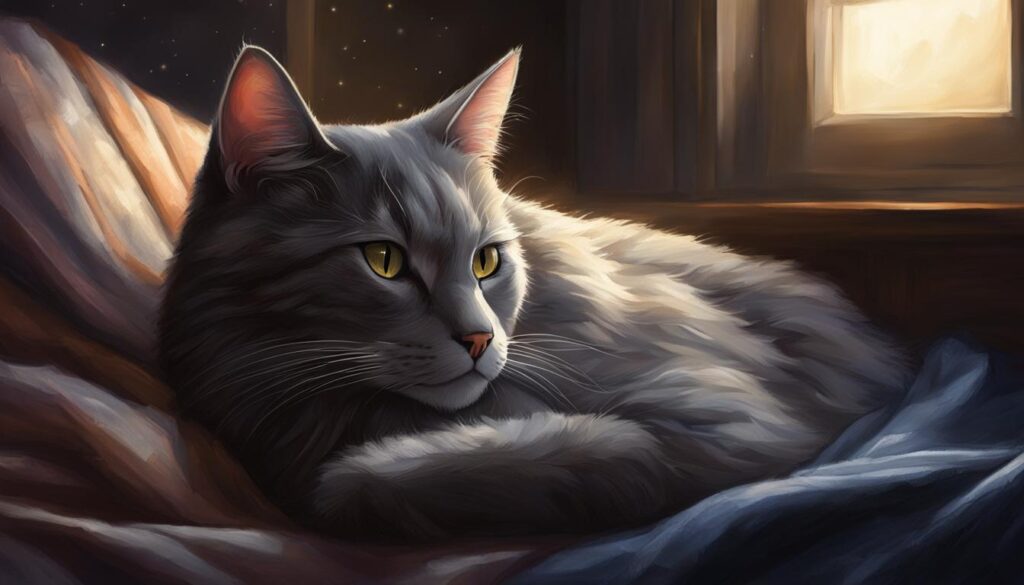
Conclusion
Cat sleep patterns can be mysterious and challenging to manage, but understanding their crepuscular nature is key to establishing a peaceful coexistence during the night. As an avid cat lover, I have learned that cats are not nocturnal but rather most active at dawn and dusk, aligning with their evolutionary heritage as hunters. Accepting their natural sleep-wake cycle and providing appropriate outlets for their energy can help mitigate nighttime disturbances.
By adapting our routines and creating a cat-friendly night routine, we can support our feline companions’ instinctual behaviors. Engaging in interactive play sessions before bedtime allows them to fulfill their hunting instincts, while cozy and quiet sleeping places provide them with a sanctuary for rest. It’s important to avoid reinforcing unwanted behavior by withholding attention when they wake up at night.
If you find your cat’s sleep patterns significantly changing or are concerned about their nighttime behavior, consulting with a veterinarian can help identify any underlying medical issues or sleep disorders. Understanding and accommodating age-related changes in senior cats’ sleep patterns is also crucial for their well-being. Regular wellness check-ups and providing comfort and easy access to resources can contribute to a healthy sleep routine.
Remember, cats’ crepuscular nature is part of their essence. Rather than trying to change it, let’s embrace and work with their instincts. By providing physical and mental stimulation during the day, creating a cat-friendly night routine, and seeking professional assistance when necessary, we can create a harmonious sleep environment for both ourselves and our feline friends.
FAQ
Are cats nocturnal?
No, cats are not nocturnal. They are crepuscular, which means they are most active at dawn and dusk.
How many hours do cats sleep a day?
Cats sleep for an average of 15 to 20 hours a day, with older cats sleeping even more.
Why are cats most active at night?
Cats’ evolutionary history as hunters of prey during dawn and dusk influences their sleep patterns, making them most active at night.
My cat is keeping me awake at night, what can I do?
Providing dedicated playtime during the day, as well as toys to occupy cats during the night, can help redirect their energy and minimize nighttime disturbances.
How can I create a cat-friendly night routine?
Engaging in interactive play sessions before bedtime, providing cozy sleeping places, and ensuring access to fresh water and meals can help create a cat-friendly night routine.
What can disrupt a cat’s sleep?
Certain factors like medical conditions or pain can disrupt a cat’s sleep. It’s important to consult with a veterinarian if a cat’s sleep patterns significantly change.
How can I promote a peaceful night’s sleep for my cat?
Keeping litter boxes clean and well-lit, providing cozy sleeping areas, and avoiding playing with cats on the bed can create a calm sleep environment for cats.
Do senior cats have different sleep patterns?
Yes, senior cats may have variable sleep-wake cycles and age-related physical changes that can affect their sleep quality.
How can I manage my cat’s nighttime behavior?
By understanding and accommodating their natural nocturnal tendencies, providing physical and mental stimulation during the day, and creating a cat-friendly night routine, you can effectively manage your cat’s nighttime behavior.


